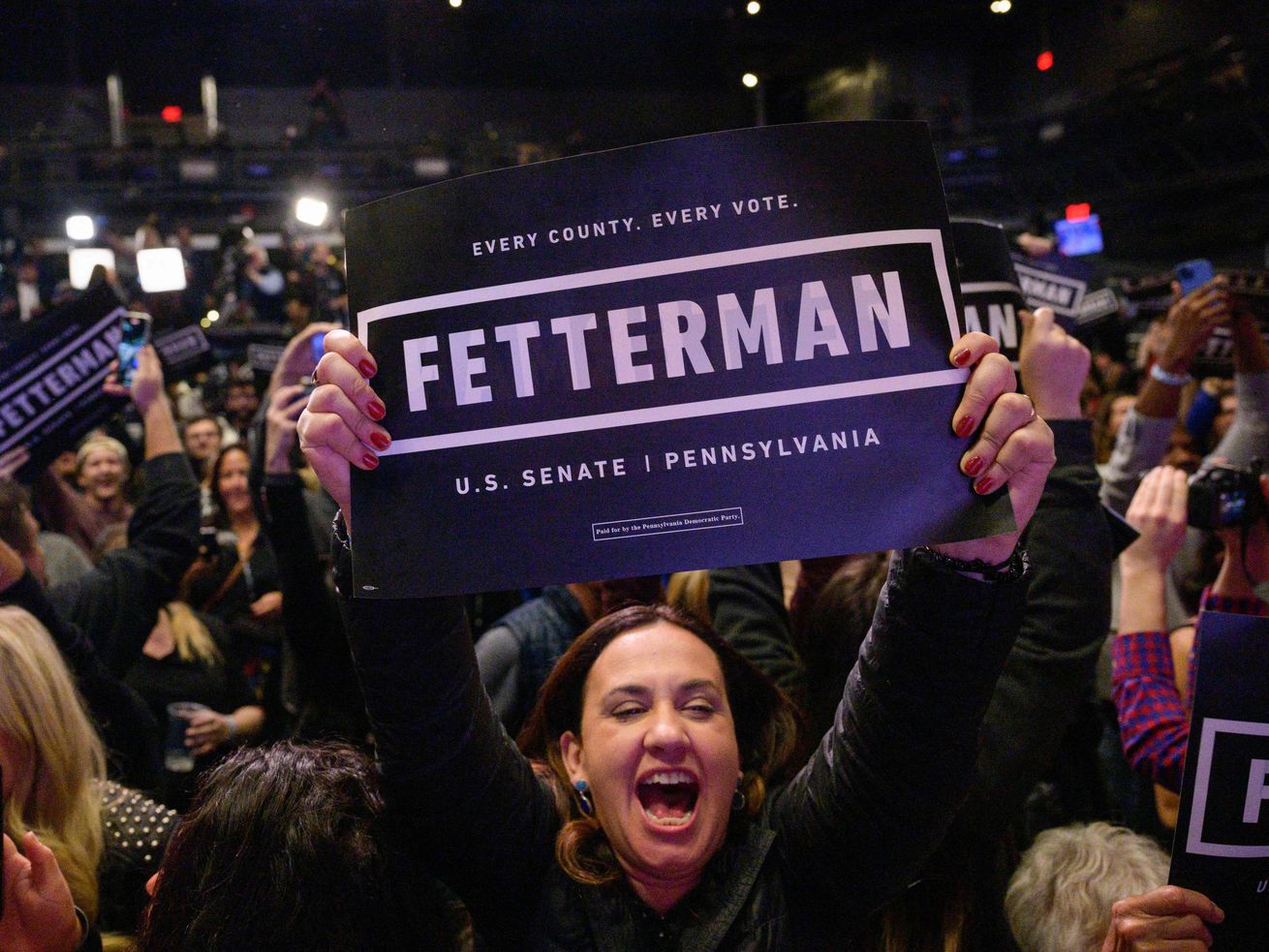The media fell for a false “red wave” narrative.
In the months leading up to the midterms, many pundits and politicians thought that Republicans had momentum enough for big gains at the state and federal levels, enough to count as a “red wave.” But veteran Democratic strategist Simon Rosenberg is one of a few voices in Washington who, despite President Joe Biden’s sagging approval ratings and polls that showed Democrats playing defense on inflation, remained optimistic about the party’s prospects and who was ultimately vindicated by a strong performance.
Rosenberg — who has previously advised the Democratic Congressional Campaign Committee and is the president of the progressive think tank NDN — says he’s not in the business of predictions. But he thought that the available data consistently pointed to a competitive election, and he became a self-described “info warrior” on Twitter trying to convince the pundit class of that. He believes that, unlike in 2016 and 2020 when polling failed to register Trump’s strength as a candidate, this time around, it was the media analyzing the polls who got it wrong.
“There was a massive media failure this cycle,” he said. “The failure that just took place is more grave than the polling error [in 2020] because there were a lot of really smart people who basically misled tens of millions of people through their political commentary in the final few weeks.”
It’s hard to know whether there was a practical effect of the doom-and-gloom stories about Democrats in the months before the election — whether it suppressed turnout by demoralizing voters or motivated them to show up because they feared what would happen if they didn’t. But even if any negative effect was small, that might have made a big impact.
“My own view is that it probably net cost us. It could have cost us the House,” Rosenberg said.
Here’s what he thinks went wrong.
Real election results weren’t given enough credence over polls
Rosenberg has been arguing that Republicans made a huge mistake in running toward Trumpism since November 2021, when he first challenged the notion that there would be a runaway red wave in the midterms.
That hypothesis gained a wider following over the summer amid backlash against the Supreme Court’s decision to overturn Roe v. Wade. But there was a significant vibe shift in the fall, when Democrats’ margins on the generic ballot narrowed and they showed relative weakness in polls on issues like the economy and crime. Those seemed like signs that outrage over Roe had waned and that Republicans had the edge.
Rosenberg doesn’t think that was ever true and that available data showed an election where Democrats were favored in the Senate and the House was up for grabs. The clearest indication came from actual election results.
“Real voting is more important than polling,” Rosenberg said. “The way you interpret an election is looking at how people vote.”
Republicans had doubled down on a brand of politics that had just been twice rejected by the American people in 2020 and 2018. And a series of special elections that occurred over the summer showed a similar pattern, with Democrats significantly overperforming across House races in Nebraska, Alaska, Minnesota, and New York. In Nebraska’s First District, for instance, the Democrat lost by less than 6 percentage points, compared to more than 20 percentage points in 2020. And Democrats won a House seat in Alaska for the first time in half a century, defeating former Gov. Sarah Palin.
In August, voters in deep-red Kansas also showed up in supercharged numbers to vote against a proposed constitutional amendment that would have allowed state lawmakers to further restrict abortion access following the Supreme Court’s decision to overturn Roe.
All of that supported the notion that Democratic enthusiasm was up and that this wasn’t a normal midterm election, even as the polls narrowed and Biden’s approval rating was still underwater.
“People should have started adjusting their understanding of the election at that point. They didn’t — they stuck with the old models. They got bamboozled by the red wave narrative,” Rosenberg said.
Polls were misinterpreted
When the polling averages narrowed in the fall, it was partially because partisan polls commissioned by Republican organizations were bringing them down for Democrats. Rosenberg was one of the first to identify the phenomenon, which he described as an “unprecedented campaign by Republicans to flood the polling averages in the final month to create this impression of the red wave.”
If you were looking at polling averages that included Republican polls, “you were looking at a completely different election than we were looking at,” he added.
When Rosenberg stripped out the partisan polling, he foresaw an election in which New Hampshire, Arizona, Georgia, and Pennsylvania were leaning Democrat, Nevada was too close to call, and Ohio, North Carolina, and Wisconsin were leaning a little Republican. That’s consistent with what actually transpired.
It’s not clear whether the onslaught of partisan polls represented a deliberate attempt by Republicans to change the narrative of the election and dampen Democratic enthusiasm. But it may have had an outsized effect on the averages this year because of a lack of public independent polling. As Politico pointed out, big players like NBC News didn’t commission any state midterm polls this year, and the New York Times only did so in four individual House races and five states — far fewer than the number they’ve previously commissioned.
The media was also too reliant on issue polling, which can be misleading if you’re just looking at the aggregate numbers across parties, Rosenberg said. Crime and immigration were among voters’ top issues overall because they are high-priority issues for Republicans. But if Democrats were trying to turn out their own voters, they needed to focus on the issues that matter to them.
In general, it’s also hard to parse issue polling. Voters may say that they care a lot about a whole range of issues, but that doesn’t necessarily mean that any one of them will impact their decision to vote for a particular candidate or to vote at all.
“This reliance on the most important issue among all voters was playing into Republican talking points,” Rosenberg said.
The enduring salience of Roe was underestimated
The anti-abortion movement lost big time in 2022: Democrats running on pro-abortion rights nearly swept the table, and every ballot initiative aimed at restricting abortion lost, while ballot initiatives strengthening abortion rights prevailed and even outperformed Democratic candidates in some cases.
Though we shouldn’t put too much stock in exit poll data, which is incomplete at this point, KFF’s analysis of the AP VoteCast survey found that the Supreme Court’s decision to overturn Roe had a “major impact” on whether roughly four in 10 Americans decided to vote this year and that it activated key constituencies for Democrats, including Black and Hispanic women under the age of 50, voters under the age of 30 overall, and first-time voters. That’s consistent with strong post-Roe voter registration numbers: The number of women who registered to vote increased by 35 percent across 10 states in the month after the decision came down.
As my colleague Rachel Cohen wrote, Republicans and their grassroots have struggled to confront just how pivotal the end of Roe and their subsequent efforts to curtail abortion rights proved in this election. And that appeared to seep into media coverage, with many media outlets projecting before Election Day that abortion had receded from the spotlight in favor of inflation, an issue where Republicans thought they had the edge.
“The debate over abortion rights has not emerged as a political silver bullet for Democrats,” the New York Times declared on November 4.
Rosenberg speculates that male political commentators were particularly receptive to the Republican narrative on that front.
“I think that they were unsympathetic to this idea that abortion really was going to be one of the two or three things that drove the election,” he said.
But the evidence was always in the polls: Interest in abortion didn’t drop over time and, among Democrats, actually increased across several tracking polls. And Rosenberg thinks its salience won’t wane anytime soon.
“This could be creating a millstone around the Republican Party’s neck — not just in this election but for many elections to come, and potentially may alienate an entire generation of young people,” he said.
Author: Nicole Narea
Read More



